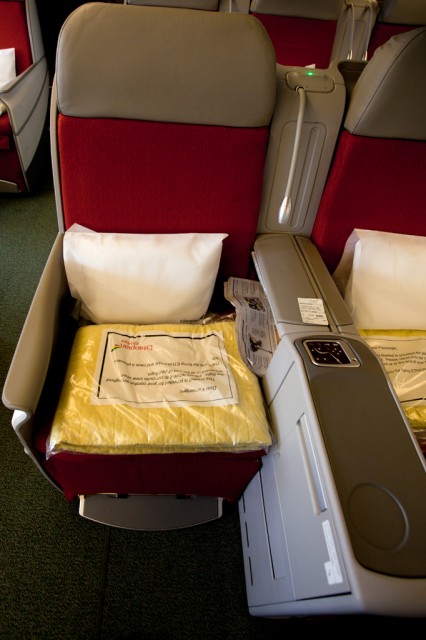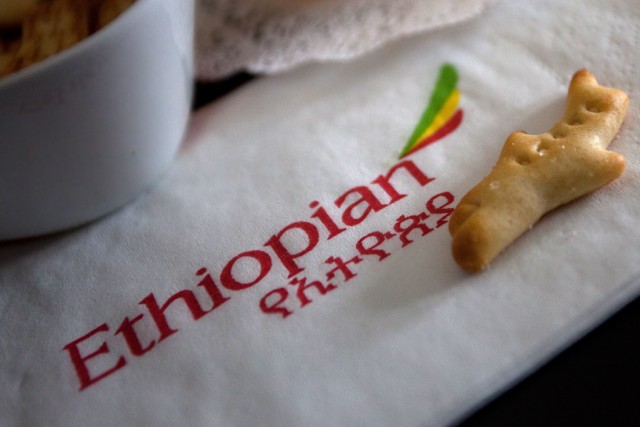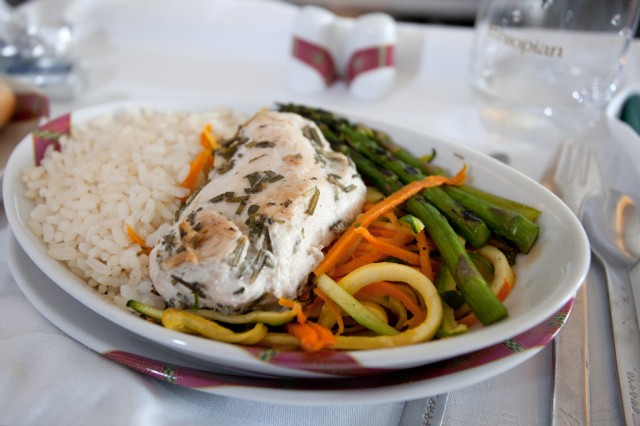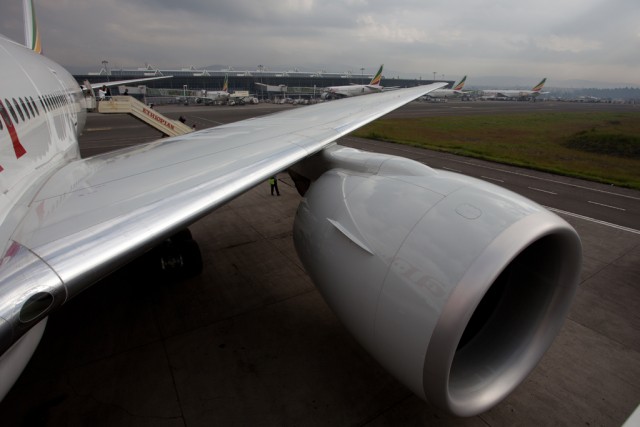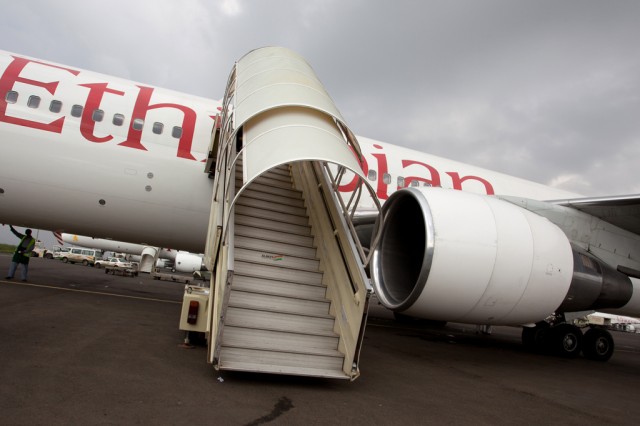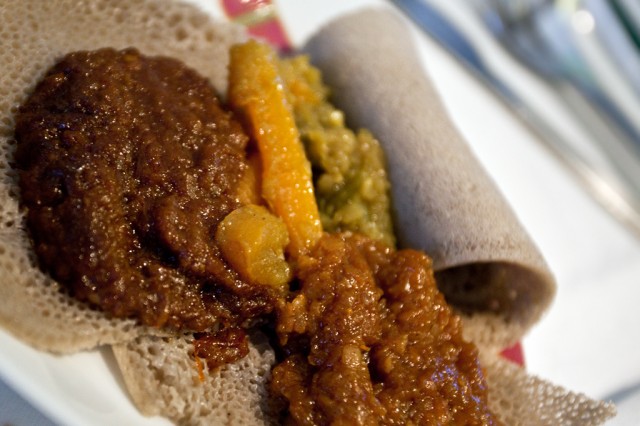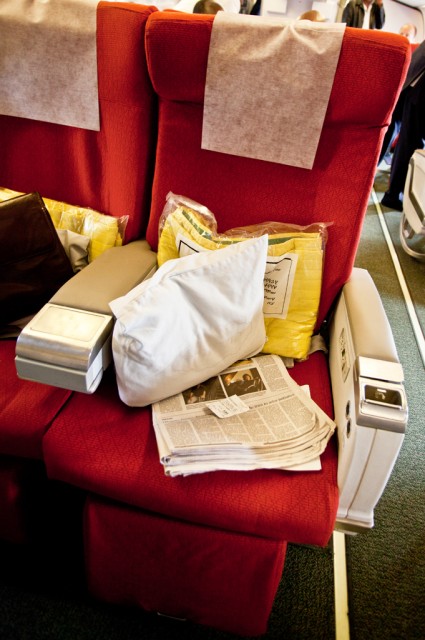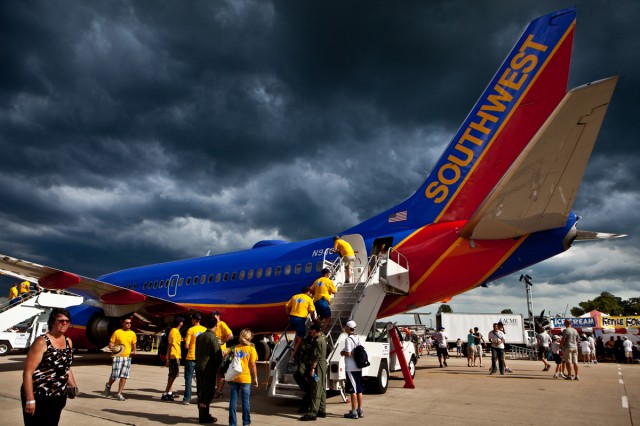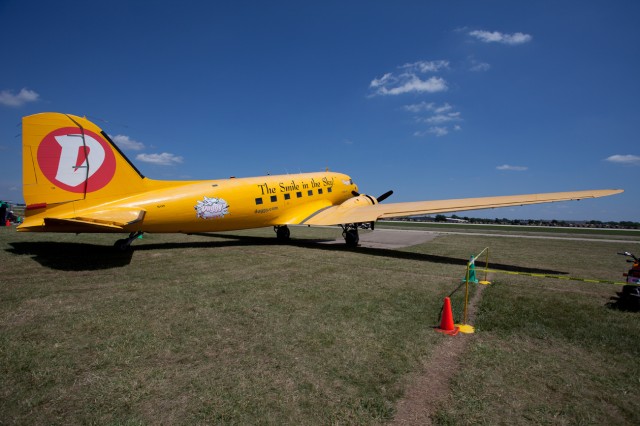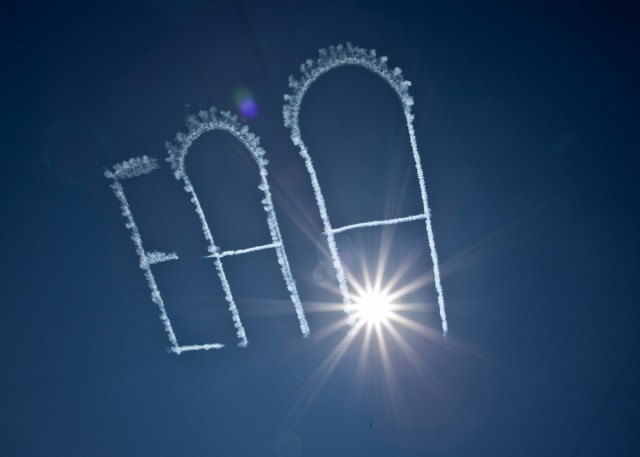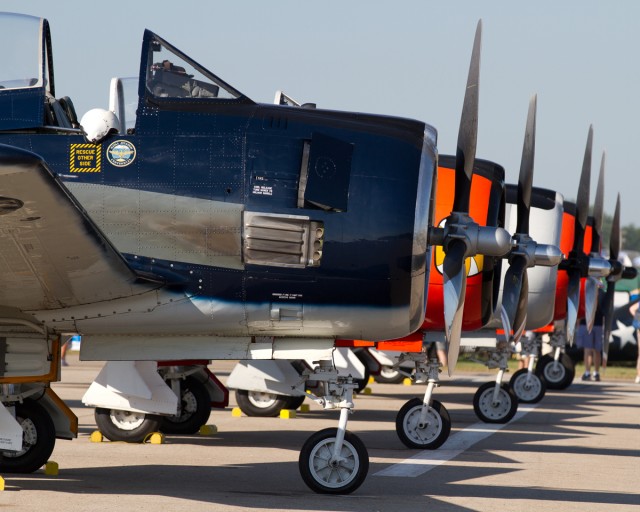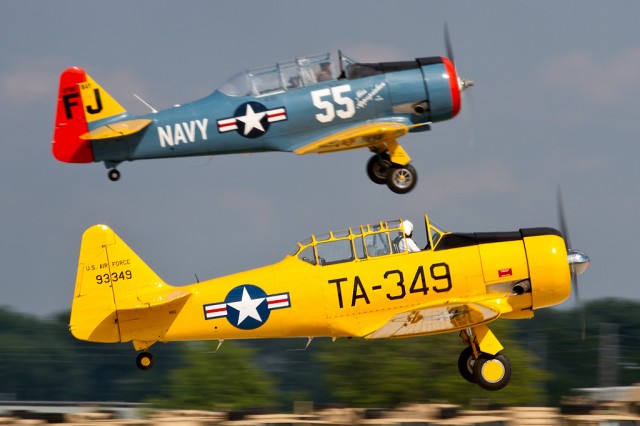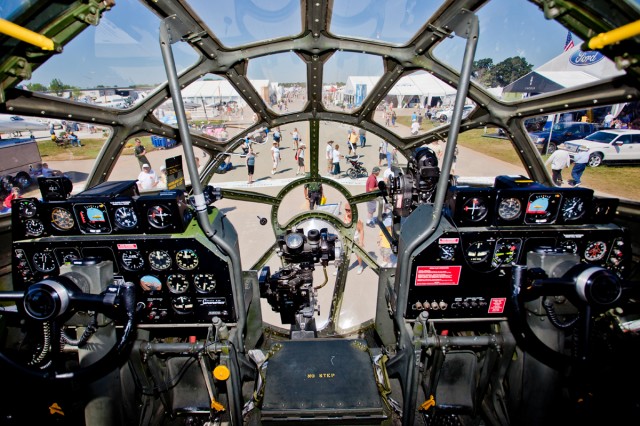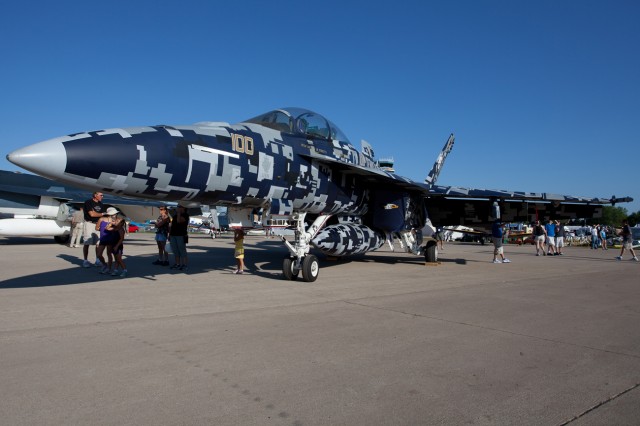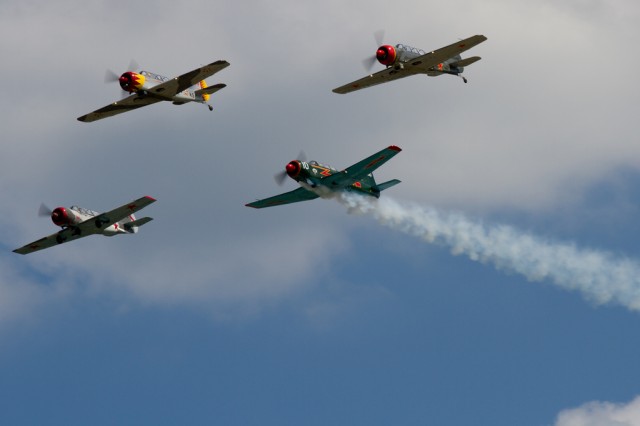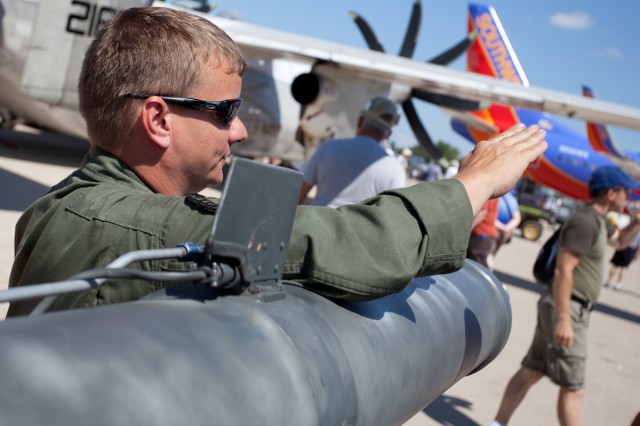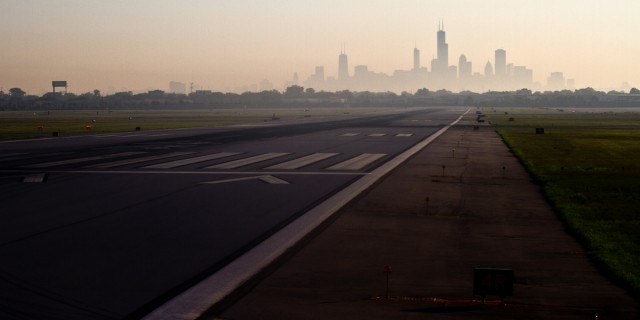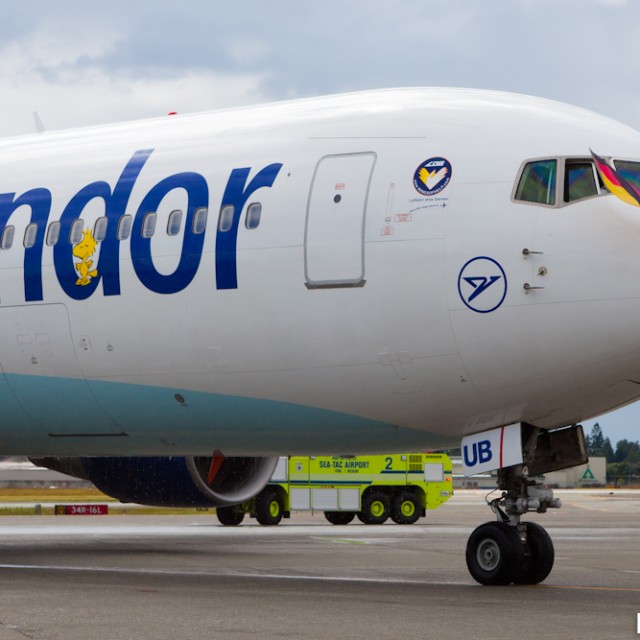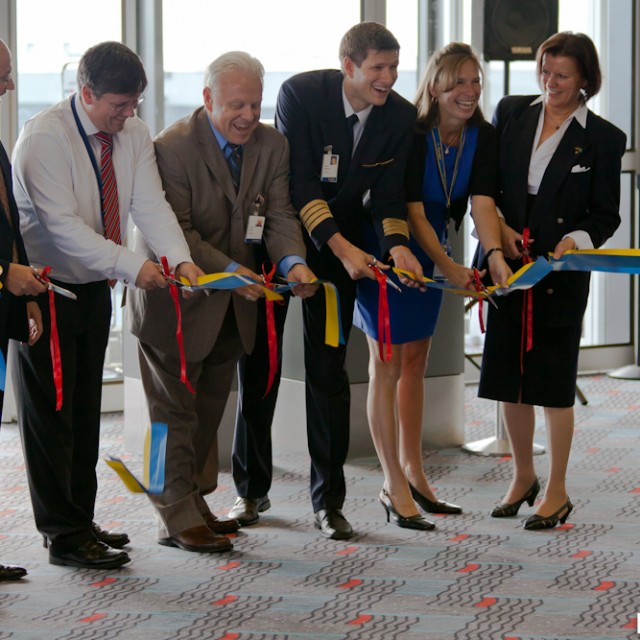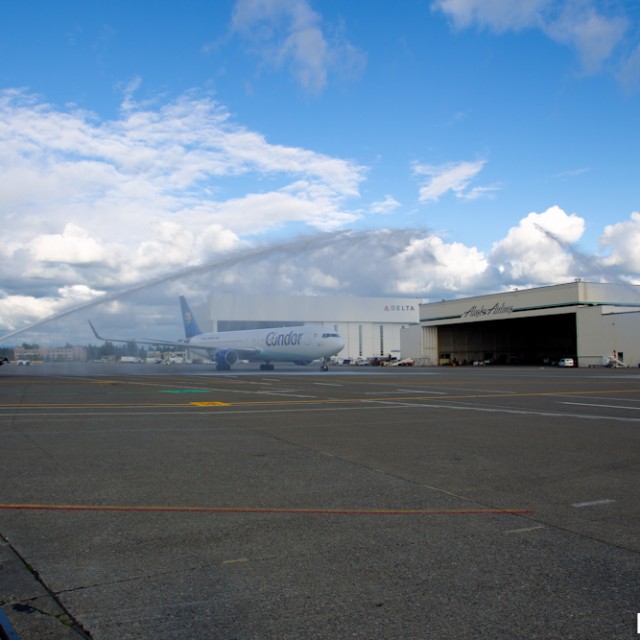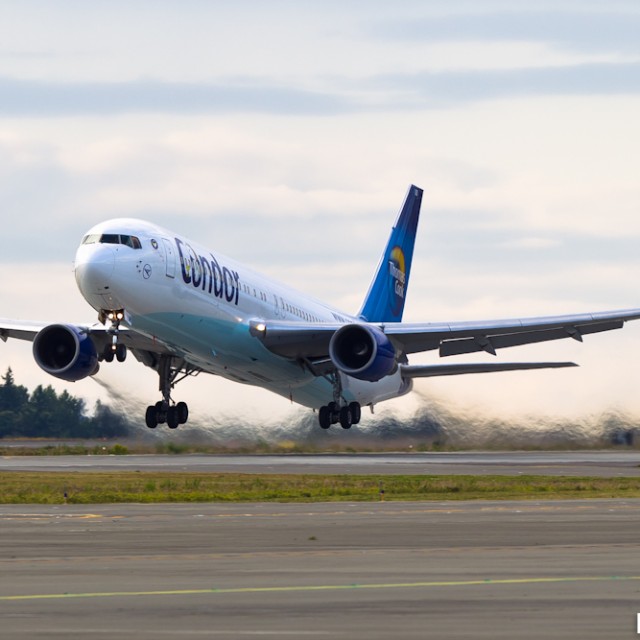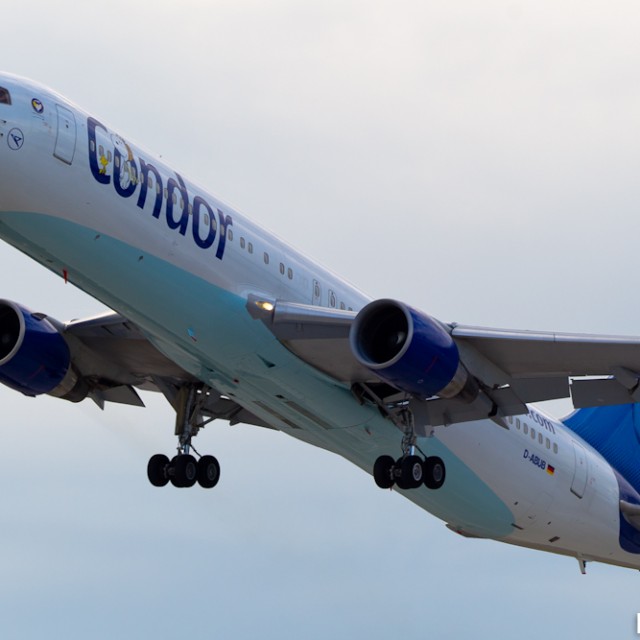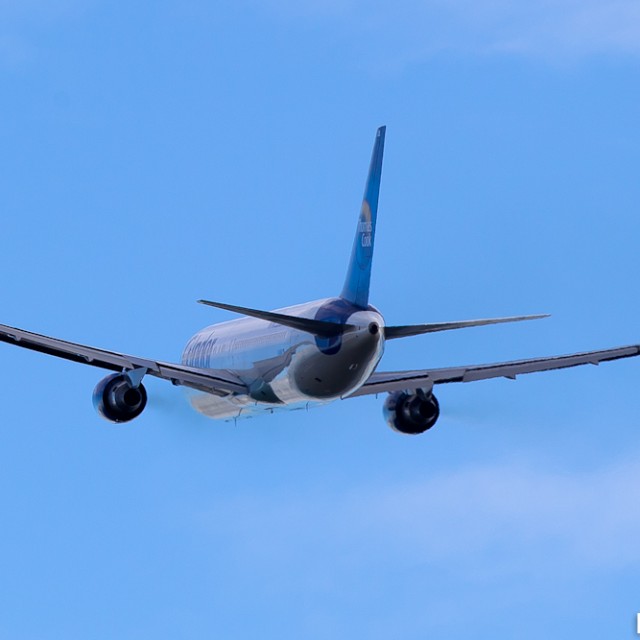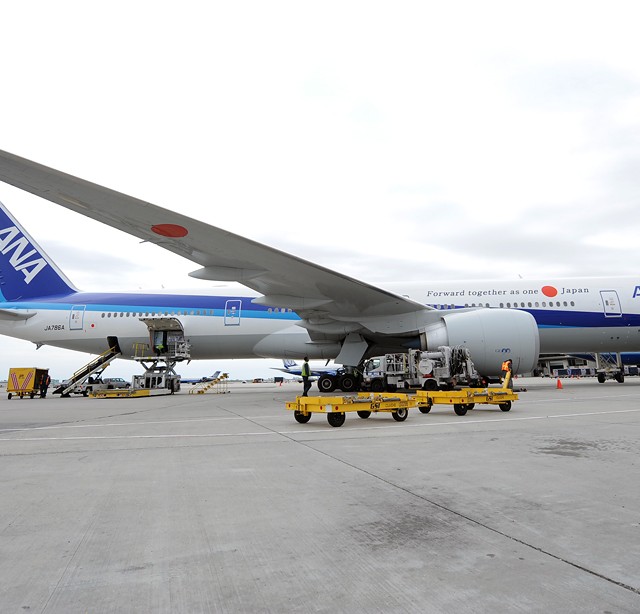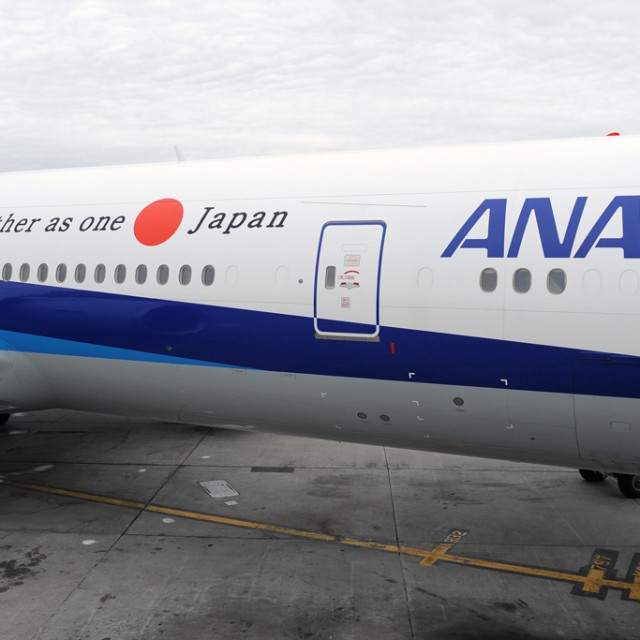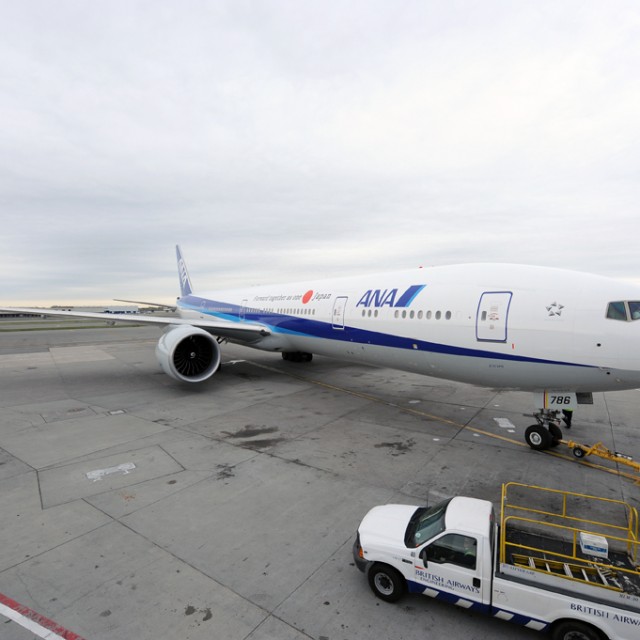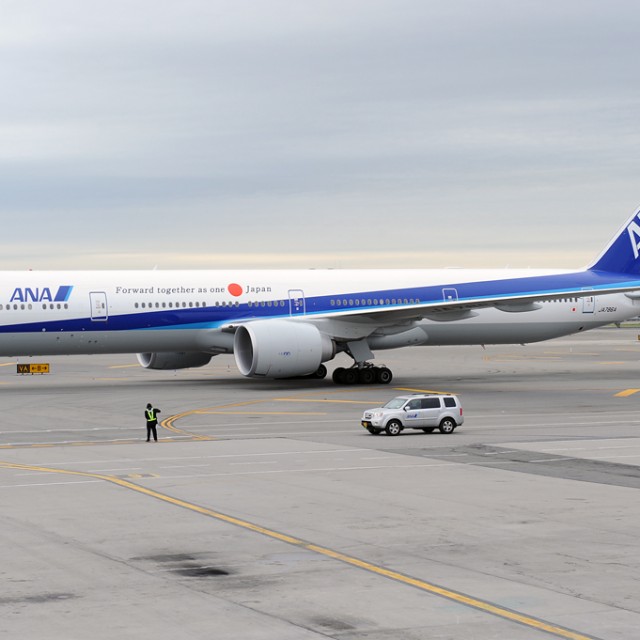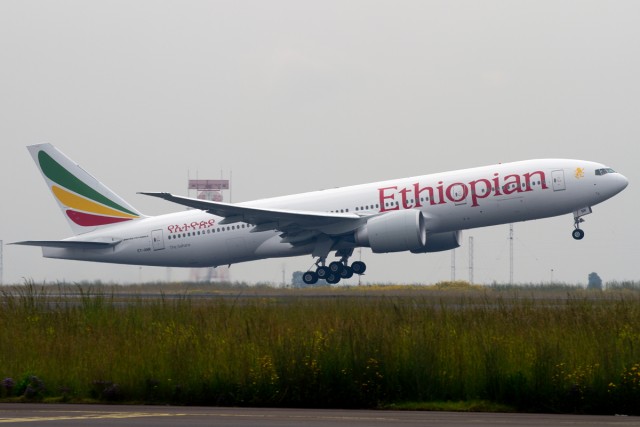
A Boeing 777-200LR takes off from Addis Ababa's Bole International Airport. Photo by Jeremy Dwyer-Lindgren / NYCAviation
Jeremy Dwyer-Lindgren, who works for the site NYCAviation.com, had the opportunity to fly on an Ethiopian Airlines business class flight on a Boeing 777 and 767. I thought the story was great and am able to share it with my readers. Here is his story in his own words:
ADDIS ABABA, ETHIOPIA: This is the second of a three part series on the airline, with this segment focusing on their business class service named Cloud Nine. NYCAviation (NYCA) had the opportunity to review this service on two international flights: Washington Dulles to Addis Ababa and Addis Ababa to Johannesburg. Ethiopian provided the flights to NYCA at no charge, flying on both legs in September 2011.
Part I Addis to DC
Ethiopian Airlines Flight 501 Service to Addis Ababa from Washington Dulles
Boeing 777’200LR ET’ANR
Dep: 1201/EDT Arr: 0738/EAT
Seat 03H / Cloud Nine Business Class
Stepping onto the curb in a rainy Washington DC, I made my way to the Ethiopian Airlines (ETH) counter, which is tucked in the back off to one side. Check’in was short and sweetabout 15 minutes start to finish. I took advantage of ETH’s two’checked’bags policy and left one bag in their care. At the ticket counter I had been assigned seat 20B, but at the gate I was upgraded to seat 03H in Cloud Nine.
Boarding was a breeze. Cloud Nine passengers, members of ShebaMiles and other preferred’status folks boarded first. I was the third person to walk onto the large, new Boeing 777’200LR (ET’ANR). Ethiopian’s business class on the B772 (the airline has no first class) is configured as 2’3’2, with 03H in the middle section on the aisle. As the passengers settled in before we departed on this 12+’hour flight, drinks ranging from juice to liquor and copies of Le Monde and The Washington Post were offered.
Dulles was unusually slow that day, which allowed a nearly on’time departure (about 10 minutes late) from Runway 33. A Saudi Arabian Airbus A340’300 and the ever’elusive Boeing 747SP on the remote ramp enhanced the view as the 777’s wonderfully massive GE’90 engines spooled up. We climbed out over the Washington Metro area and headed northeast.
Following an hour long power nap just after departure, I awoke to the sounds of drinks being served. A selection of juice, soda and top’shelf liquor was offered along with salted airplane shaped crackers. Lunch service followed shortly thereafter.
The hors d’oeuvres were sweet chili bay scallops, citrus’cured smoked salmon and sliced bresaola (air’dried beef) served with salad and warm bread and butter. The beef was spicy and good. I don’t eat fish or seafood and so passed up the other choices, but they looked excellent. A salad, also provided, was OK.
We were asked to choose an entre: beef, chicken, fish or vegetarian. I opted for the seasoned chicken breast with vegetables in teriyaki sauce and rice with asparagus. The meal was good and satisfyingthe chicken was tender and moist, the vegetables crisp and warm. It came with more bread and butter. After the meal, dessert ’ a slice of coconut cheesecake for me. Service was quick and friendly (perhaps too quick: While no one rushed me through a course, I couldn’t help but feel a bit hurried), and capped off by the traditional coffee service.
Four hours in the sun was already setting. While much of the cabin settled in for the night, I went for the entertainment system. A wide selection of TV and movies in multiple languages are available along with games, flight tracking maps and other options. The touch screen is large; 15.4 inches wide. With the screen nestled into the seat back in front of you it requires a stretch to reach, but the tethered remote takes care of that. The remote itself is a bit less intuitive than I would’ve liked, and at times it was easier to use the touch screen than fiddle with it. The airline provided a bagged set of their own headphones, which got the job done. During the flight I watched a few movies, some TV, and played BlackJack (a shame that it wasn’t with real money).
Sleep came shortly thereafter and I found myself able to manage about five hours of solid rest. Utilizing a shell based design the Cloud Nine seats are considered angled lie’flat and have a respectable 65 inches of pitch: they even has a massage function to help loosen up the muscles. The other details are pretty standard: a large, fold’out tray tucked into the side of the armrest, adjustable reading light, foot rest and a pillow & blanket set. The only downsides were lack of power outlets and the seat not being terribly private: an adjustable divider between the seats would have been welcome. Ethiopian’s one carry’on policy kept overhead space easily available.
While sleep was welcome and need, unfortunately I slept through the second meal service. According to my menu I missed out on a selection of culinary delights ranging from mini beef meatballs and chicken satay to mini pizza and jalapeno poppers. I trust that they matched the positive experience of the first meal service.
With two’and’a’half hours remaining the final meal service began: breakfast. Again the food was enjoyable and plentiful. There were a few options; I chose the cheese omelet with hash browns, chicken sausage and sauted mushroom with a grilled tomato ’ complimented by a fresh fruit salad and yogurt.
As the flight neared arrival a stop to the lavatory to freshen up was in order. A packet of amenities, located in the seat, contained toothpaste and brush, comb, mouthwash, sleeping mask, and a handful of other items. Nothing to write home about, but after a long flight the ability to brush your teeth and comb your hair in the lav is welcome.
We landed early into Bole International Airport at 0738 local time. Taxi was fast and we quickly pulled up to a remote gate complete with air’stairs. Deboarding was quick and efficient as Cloud Nine was let out first, with a minibus exclusively for business class greeting us at the bottom of the steps. Once on the mini’bus we were whisked away to the terminal, which is a bit of a challenge to navigate the first time. Having a very short connection I was directed by staff up an empty boarding gate to get to the arrivals level. The terminal was very busy, but staff were helpful in directing me to my already boarding connection, where another adventure was about to begin.
Part II Addis to Jo’Burg
Ethiopian Airlines Flight 809
Service to Johannesburg from Addis Ababa
Boeing 767’300ER ET’AMQ Dep: 0910/EAT Arr: 1315/SAST
Seat 01D / Cloud Nine
[This flight picks up where the previous flight, Ethiopian 501 from Washington Dulles, leaves off.]
Having arrived safely at Addis’ Bole International, I quickly made my way toward my next flight. By the time I stepped into Terminal Two my connecting flight was already boarding. Lacking a jet bridge, a Cloud Nine dedicated mini’bus drove us out to the remote gates and we met up with our Boeing 767’300ER (ET’AMQ). A quick jaunt up the airstairs (these big jets always sit higher off the ground than I think they do), and I find myself seated in 01D.
Much like on the prior flight, the forward cabin staff were up and about serving drinks as passengers settled in for the five or so hour flight. We departed about 20 minutes late with a powerful and aggressive climb out from Bole (the airplane was probably only two’thirds full). The flight path had us tracking over a number of exotic locations through the African interior that, thanks to an aisle seat were largely unseen. About forty minutes into the flight a full drink service was offered along with little airplane shaped crackers, which I complemented with a delightful glass of Irish Cream.
Lunch began very quickly thereafter, and like the prior flight, the food matched expectations for business class. The hors d’oeuvre consisted of smoked salmon garnished with asparagus tips and sun dried tomato, turkey slices with red pepperoni and corn on the cob, and lamb terrine garnished with cherry tomato and dried prune. These were supplemented with a seasonal salad with fresh greens and an olive oil based vinaigrette along with bread and butter.
We were next served a course featuring the Ethiopian National Dishes. Each course came with a staple of Ethiopian meals known as injera. It is akin to flat bread though with a spongy texture and unusual taste. Atop the roll of injera one had the option of mixing and matching sampler sized portions of various stews (Wot) (though I would liken the consistency more to curry than stew). I chose to go with Doro Wot (spicy stew), Ataklet Wot (mixed vege), and Miser Wot (lentil’based). They were all quite enjoyable and doled out in such large portions that I actually thought this course was the main entree. It was not though, and the actual entree was a choice between beef, chicken, fish, and vegetable. I went with the beef in cumin sauce with basmati rice and sauted carrots along with an Ethiopian beer called St. George. The meal was enjoyable enough but I was already quite full from the previous two courses, and consequently I ended up not finishing it.
A nap was in order after the very filling meal service. Despite its age and appearance, the seat was quite comfortable. It reclines to a respectable 59 inches of pitch, which was enough to lend me a solid one hour nap. I didn’t have anyone seated next to me in the 2’2’2 configured cabin, so privacy wasn’t really an issue’“but had there been someone next to me I can’t say I would’ve been entirely comfortable taking a nap. The seat also features the standard tray in the armrest, audio jack, and is provided with a pillow and blanket. There was ample leg room. It may not be fancy, but it gets the job done. With an hour and a half remaining I caught some of the programming on the projector screen in front of me. The audio, provided by Ethiopian headphones, functioned just fine. The very large screen being only a few feet in front of me became a bit overwhelming to watch, but that was more a matter of location of my seat’“one row back would’ve made a big difference.
A care kit containing basic items like comb, toothpaste & brush was provided toward the end of the flight. It was nice to clean up a bit before landing and feel slightly more refreshed and ready for the day ’“ especially after you’ve been travelling for nearly 35 hours.
Final approach into OR Tambo was a bit rough, but that just made it fun. We touched down on time at 1315. Taxi was fairly quick and we pulled up to a gate flanked by a handful of Boeing 777s. Cloud Nine passengers deplaned first, allowing a quick and easy beeline to customs. With no competition in the customs line the entry process lasted a grand total of ten minutes. Bags, including mine, arrived about fifteen minutes later.
Part III The Bottom Line
We will take up Flight 809, service to Johannesburg, first. This one is a bit hard to judge. Looking at the schedules, the flight is operated by a mixture of aircraft; chiefly the Boeing 767-300ER (B767) and Boeing 757-200 (B757), though the carrier’s 737-700s are capable of performing the route as well. Like many airlines, cabin layouts and features vary within an individual type and Ethiopian is no exception. Consequently, experiences can differ from day to day depending on the plane. As a result, it seems worthwhile to distinguish and judge product and service separately.
In terms of product, flight 809 left a bit to be desired. This is almost entirely a result of the antiquated entertainment system. Most travelers on Ethiopian B767s will have a personal TV with a well stocked range of on-demand entertainment, but a handful will receive the retro-treatment. Charmingly nostalgic though it is for an aviation fan, most customers would likely feel it falls short of a competitive business class product on the international scene. On a five hour flight this is not really the end of the world, but many are used to having personalized entertainment options on these trans’continental flights. The seat appeared to be a bit dated as far as competing products go but was ultimately very comfortable with generous seat pitch.
Equally as important as product is service. In this respect, Ethiopian excelled on the flight. The food was good and plentiful, and those not familiar with Ethiopian fare will have an opportunity to sample something new and exciting. The cabin crew was professional and attentive.
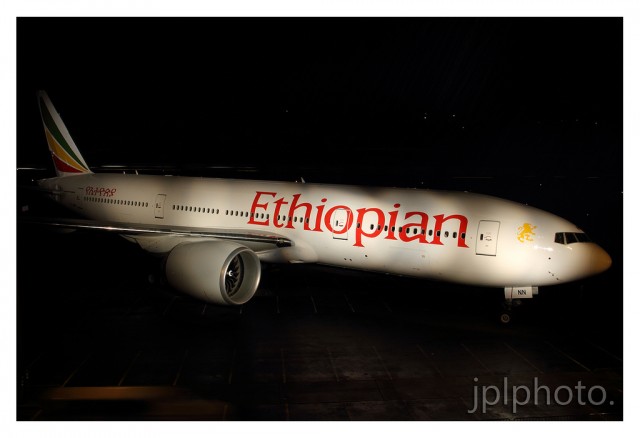
Ethiopian 777-200LR ET-ANN taken at Boeing Field in Seattle. Photo by Jeremy Dwyer-Lindgren / NYCAviation.
Taking up Flight 501, Ethiopian Airlines service to Washington Dulles is not new, but it certainly feels as though it is. The introduction of the new B777’200LRs to replace the previously utilized B767’300ERs is a serious upgrade to the route on many levels, the least of which is the inbound leg becoming a true non’stop. Boeing 777’based Cloud Nine class represents a big step up for Ethiopian and a presents a true competitive product on the international market, particularly for an African based carrier. The fresh cabin and modern product does not disappoint. Customers flying this route (or the outbound Flight 500) will find friendly and fast on board service, enjoyable food, a good seat, and quality on-demand entertainment options.
Overall in terms of service, the verdict on Cloud Nine is pretty easy: good. Cabin crews on both flights were attentive, friendly, and professional. Food was plentiful, warm, and good quality. The only inconsistency was not having served the Ethiopian National dishes on flight 501, though the airline points out that serving the meals require traditional preparation, cooking, and serving procedures which require time and care.
It is reasonable to say, however, that business class can be a bit varied in terms of product. On the one hand the B767 cabin on Flight 809 appeared to represent a business class of days gone by. On the other, the B777 cabin on Flight 501 represented a modernized, competitive product of today. The airline has told NYCA that they intend to upgrade seven Cloud Nine cabins aboard the B767, a welcome step toward ironing out the inconsistent product in their B767 fleet. Looking to the very near future, the airline is anticipating delivery of their first Boeing 787 Dreamliner in the summer of 2012. No doubt the new cabin aboard their Dreamliners will continue to build upon the successful choices made on their B777-type business cabins.
When the upgrades and fresh aircraft meet up with the already solid in-flight service, the future is even brighter for Cloud Nine. If a trip to Addis or elsewhere in Africa is in your future, flying aboard Ethiopian Airline Cloud Nine is a choice that will serve you well, both now and into the future.
